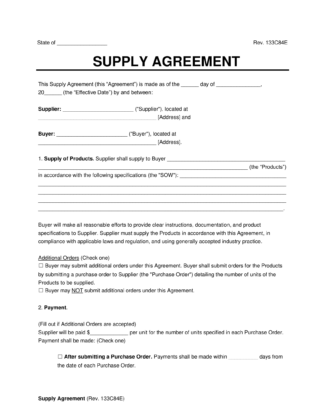
Use our supply agreement template to outline the business relationship between a supplier and a buyer.

Updated December 15, 2023
Written by Sara Hostelley | Reviewed by Brooke Davis
A supply agreement lets suppliers sell services, products, or goods to buyers. It serves as a framework for the two parties’ relationship, establishing their expectations, obligations, and rights to ensure a mutually beneficial agreement.
Here are some types of suppliers that may use a supplier agreement:
A supply agreement is a legal document outlining the terms and conditions for the provision of items or services to a buyer by a supplier. It highlights all the details of the business partnership, sets clear guidelines, and mitigates potential disputes.
For example, suppose your company designed a product. To sell the product, you might partner with a manufacturer who could produce that product. They would be the supplier, providing you with products that you could later distribute for sale.
Here are some situations in which you’d need to use a supply agreement:
Companies that regularly source services or goods from a supplier use supply agreements to establish ongoing relationships. Businesses in industries like the textile or electronics sectors that use raw materials and components can benefit from having a supply agreement in place.
A company that needs highly customized products can also use a supply agreement to define the quality standards and specifications for each order.
Buyers that intend to distribute the products they receive from suppliers will use distribution agreements, a form of supply agreements.
Resale or retail businesses use supply agreements when buying products from wholesalers or manufacturers. These documents ensure quality standards and specify pricing terms and the delivery schedule.
Parties can enter into exclusive supply agreements for high-quality or patented products. In this relationship, the buyer supplies specific items exclusively from the supplier for a specific period. This arrangement can ensure high-quality products for the buyer and provide guaranteed business for the supplier.
Companies that can’t perform specific services in-house may outsource services using a supply agreement. They can communicate the scope of services, payment terms, and performance standards to third-party suppliers.
A company may initiate a new project that it doesn’t have the current resources to facilitate. It can use a supply agreement to request goods and materials and specify the delivery timeline and other details.
Here are some elements to include within your supply agreement:
Explore the benefits of a supply agreement:
Both parties can experience significant savings with a supply agreement. They can negotiate payment terms and pricing guidelines from the beginning.
Buyers can lock in competitive prices they’d otherwise have difficulty obtaining, and suppliers can benefit from consistent business. Suppliers also won’t have to dedicate resources to pursuing as many sales opportunities because they have established contracts.
A supply agreement contains sections relating to quality control and assurance. As a result, suppliers can experience more success in meeting buyer’s standards, leading to greater customer satisfaction.
Supply agreements form steady supply chains, meaning businesses can optimize their operations and limit disruptions when sourcing the services and goods they need.
Because supply agreements contain detailed work scopes and specifications, suppliers can more easily meet industry standards and regulatory requirements. This way, both parties will abide by federal and local laws and minimize risks to their reputations.
A supply agreement helps a buyer protect intellectual property rights when they’re necessary for the production of goods by a supplier. It protects both parties from legal issues and ensures they can remain competitive without compromising sensitive information.
Here are some tips you can implement to more easily find suppliers for your business:
Use online platforms to find suppliers for the goods or services our business needs. Consider your specific niche.
If you’d like to enter a business agreement to purchase e-commerce products, use a website like Alibaba. Other marketplaces to research include MFG, Thomasnet, and Global Sources. Narrow your search by filtering suppliers by certifications, location, and product category.
Find industry events within your field, such as trade shows and conferences. Depending on how specialized your niche is, you may have to travel to a different city. It can be worth the expense, though, as you can meet suppliers in person, try their products for yourself, and establish a relationship.
Prepare to attend an industry event by researching the attendees and preparing your questions.
Research suppliers online to discover more about their offerings, customers, and reputation. See what others say about each supplier you may want to work with to determine the best way to enter a relationship.
Use your existing network to obtain referrals and recommendations. Ask your mentors, peers, customers, and trade publications if they can refer you to trustworthy suppliers.
After you have some potential suppliers in mind, contact them directly. Ask to speak to a representative who can verify the supplier’s capabilities and credentials. You can also speak with the representative to see how compatible the supplier will be with your business’s needs.
Request samples, test orders, prototypes, and quotes. Compare prices and communication styles to narrow down your options further.
Use a systematic and thoughtful approach to rank your options objectively. Use a SWOT analysis, a cost-benefit analysis, or a risk assessment to identify each one’s pros, cons, opportunities, and threats.
Download a supply agreement template in PDF or Word format below: